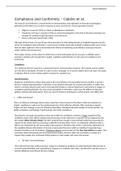Samenvatting
Summary Articles Social Influence - Cialdini et al. & Goldstein and Mortensen.
Summary of the articles 1) Cialdini et al - Compliance and conformity and 2) Goldstein & Mortensen - Social norms and how to (and how not to) guide.
[Meer zien]














